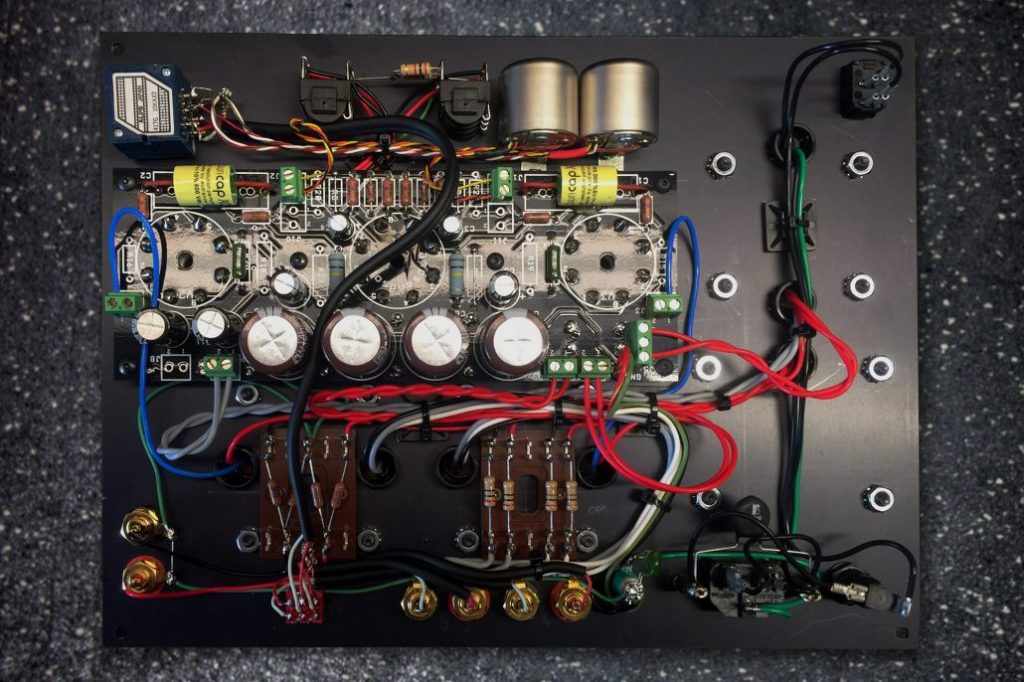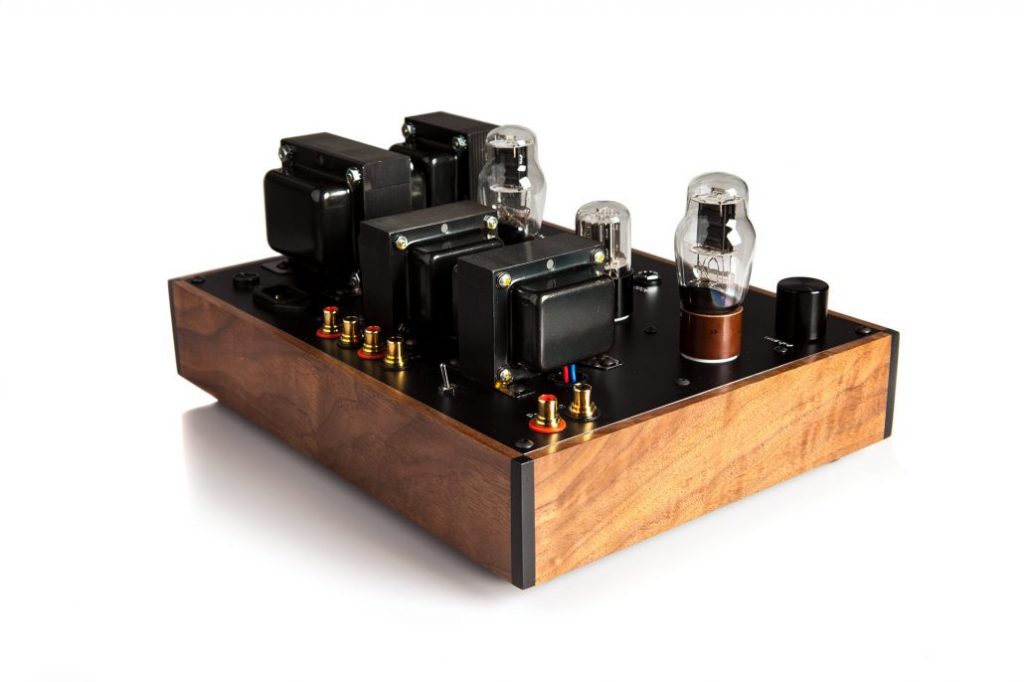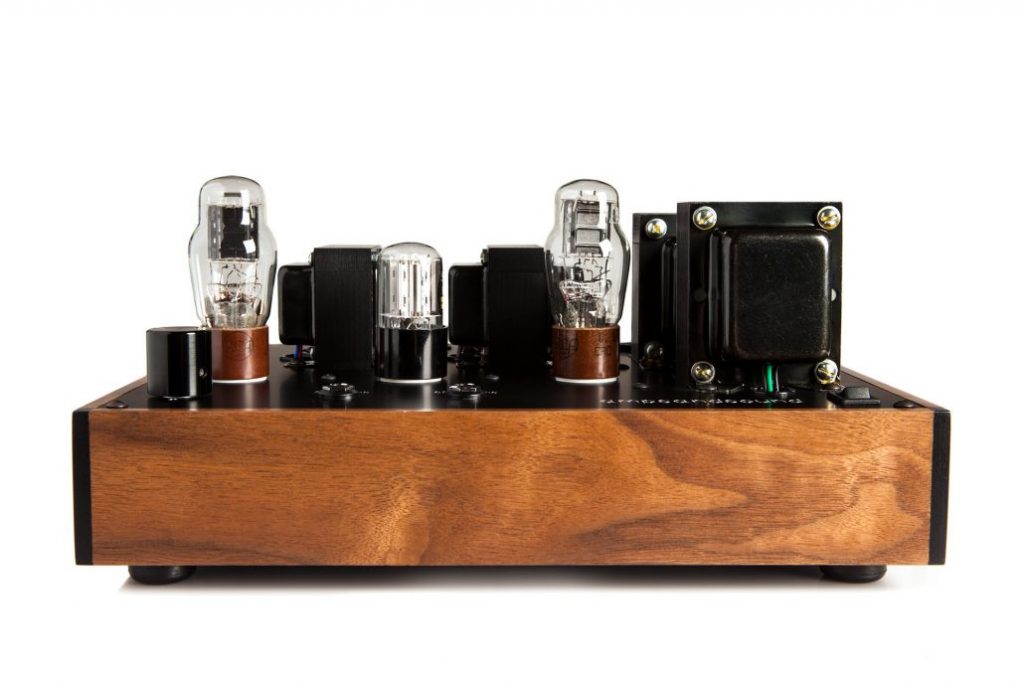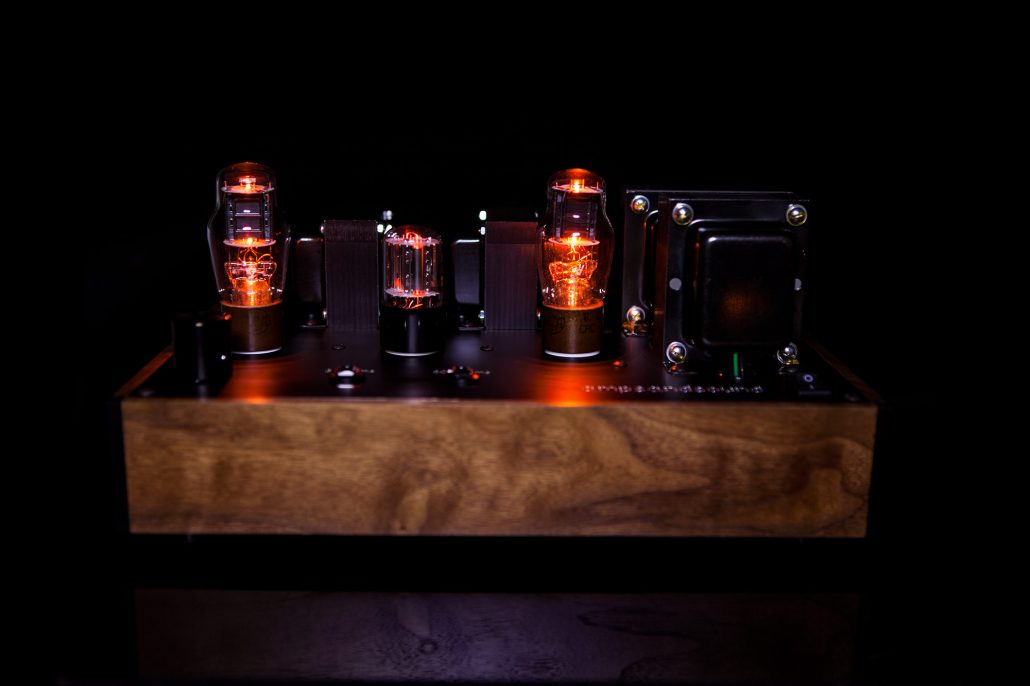Back in January of 2016 I reviewed the newly released Kenzie headphone amplifier by Ampsandsound (https://headphone.guru/the-amps-sound-kenzie-a-brilliant-new-tube-amplifier/). Being a relatively new company, the Kenzie was one of the company’s initial product offering. In short, I loved it! Everything from the design and aesthetics, to the use of inexpensive tubes to the wonderfully rich and still detailed tube sound really impressed me. Well, the founder of ampsandsound, Justin Weber has gone back to the Kenzie and has designed it from the ground up; resulting in the newly released Kenzie Encore.
Right from taking the Kenzie Encore out of the box, you can tell Justin has worked on refining the already impressive Kenzie into a more handsome and functional amplifier. The headphone outputs have been moved closer to the front of the unit for better ease of access and an easily accessible input toggle switch has been added to select between 2 un-balanced RCA inputs into the amplifier. The fit and finish; while very much in the same antique tube amplifier style as the Kenzie, has also been improved as well. This amplifier is a looker! Turn it on and let the tube glow shine through and you will have a functional work of art in your audio system!
One area that Ampsandsound really pride themselves is the level of detail and workmanship that they put into their products; both externally and internally. As from the photos provided, you can see that great care was taken to lay out the internal components and wiring of this amplifier and routed in a way that certainly meet or exceed industry practices. I am a professional engineer with over 21 years of electronics manufacturing experience and a certified IPC Instructor and when reviewing the internals of this amplifier I could very quickly tell that it exceeded many of the requirements for IPC-A-610 Class 3. Class 1 is typically reserved for consumer electronics, Class 2 is typically used for servers and higher level systems and finally Class 3 is the highest set of requirements typically saved for aerospace, medical or military applications; quite impressive!

The Kenzie Encore has substantially evolved from previous designs (namely the Kenzie) and the associated feedback received from this product from the market. So while the Encore has grown in size substantially, according to Ampsandsound, it still has remained true to the original Darling circuit. The Encore has gone from being a single-ended triode without feedback for directly driving headphones exclusively to now include a transformer coupled output (for both pre-amp duties or driving headphones directly). This in turn has resulted multiple benefits; namely lowering the signal impedance and this allows for longer capable runs and a lower noise floor. The Encore also continues without a voltage network and still has plenty of power to drive most headphones; which I will cover later in this review. Also included with the Encore are two different headphone outputs. Both 32 ohm and 600 ohm output jacks are now included on the Encore to allow for better impedance matching to your headphones to get a better desired damping factor.

The advantages of the input transformers reduces impedance spikes and generates a new ground for the signal. Many current DACs generate these high impedance spikes and these input transformers filter much of these out. This results in improved transparency overall. The Auri capacitor upgrade offers even further improvements to the great baseline of the current WIMMA capacitors used on the base model. These Auri capacitors have even tighter tolerances and have been known to improve mid range bloom and sound stage in non-feedback topographies.
When headphones are plugged in, the Encore automatically mutes the pre-amp outputs. This is very much a welcomed feature if you’re as forgetful as I am. As well, the Encore continues to use an ALPS volume potentiometer to allow for volume attenuation and simplification of the signal path. Another great carry over from the original Kenzie, is that the Encore does not require super expensive and hard to find NOS tubes like the 300b or 6SN7. These tubes can easily cost several hundreds of dollars per tube and will drive you absolutely nuts if one of them dies pre-maturely! The 1626 triode power tubes (two are used) are relatively easy to find and won’t cost you more than $15 each! This is a WWII-era transmitter tube typically used in radar installations and is also known as the “poor man’s 300b”. I am thankful to not having to spend several hundreds of dollars on the 300b tubes, so this is very much a welcomed design choice in my opinion. As well, the Encore has one 12SL7 input tube. Again finding a great NOS version of this tube won’t cost you more than $15. Now that is impressive; the Encore can be fully complimented with great NOS tubes for less than $50!
The full specifications for this amplifier are:
Input Impedance: 10k ohm with ALPS pot
Input Sensitivity: 680mV peak for full power out
Power into 32 ohms: 249 mW RMS
Frequency Bandwidth: 20Hz -3dB to 12kHz -3dB full power
Frequency Bandwidth: 20Hz -3dB to 18kHz -3dB @ 160mW output
Noise on 32 ohm tap @ 500uV
Power into 600 ohms: 398 mW RMS
Frequency Bandwidth: 20Hz -3dB to 18kHz -3dB full power
Noise on 600 ohm tap @ 1.2mV
The price for the Kenzie Encore with a compliment of NOS tubes (2 x 1626 and 1 x 12SL7) is $1,999 US. There is also a Deluxe Model that include input transformers and upgraded coupling caps (Auri) and costs $2,545 US. This review is of the Deluxe Kenzie Encore model.
Setup was a breeze. I simply replaced my “go to” standard solid state HeadAmp GS-X Mk2 headphone amplifier with the Kenzie Encore in my audio rack. However, instead of using balanced XLR cables, I used my Nordost Red Dawn ribbon RCA cables. I was able to use two different sources primarily with this amplifier. I used the Benchmark DAC3 HGC (based on the Sabre ESS9028 chipset) ($2,295 US) and the Chord DAVE ($10,595 US). This is the flaghip FPGA based DAC by Chord Electronics in the UK and is the most impressive DAC I’ve ever heard. While both DACs are truly outstanding, there are certainly different levels of “outstanding” and the Chord DAVE is at the pinnacle of this level. I wanted to test the Kenzie Encore’s ability to scale to higher levels with improved upstream sources. As noted later, I was really impressed with how the Kenzie Encore was able to let the upstream improvements shine through.

For the purposes of this review, I also used several different headphones that I have on hand to test the Encore’s ability to power and drive different headphones with different specifications. I primarily used the Sennheiser HD800S, Hifiman HE-1000 V2 and Focal Utopia headphones.

My first critical session was using the Benchmark DAC3 HGC and my iMac as a source to play k.d. Lang’s “Ingenue” (192kps bitrate) through my Sennheiser HD800S headphones. What I heard immediately had me thinking that I never realized that the HD800S headphones “were this darn good”! This was a wonderful experience from the title track “Save Me” right through to “Constant Craving”. The latter song is one my favourites by k.d. Lang and with this combination I felt as if I was pulled into the recording studio. The Kenzie Encore had such wonderful tonality and richness to it that the sometimes “thinner” sounding HD800S really hit their stride when paired with this amplifier. The bass was in perfect proportion to the mids/vocals and never once came off as slow or loose. I’ve always been a huge fan of k.d.’s vocals and through the Kenzie Encore I began to appreciate her talents on a whole new level. The wonderful richness and transparency of this combination really would satisfy even the most critical listener. The treble was wonderfully detailed and clear with a hint of being pushed back ever so slightly and in the end offered a fantastically natural sound. The ability of the amplifier to perfectly track the HD800S headphones and control their drivers with a firm grasp throughout the audible spectrum was very much a strong point. The overall sound staging was simply breathtaking and definitely one of the widest and deepest I’ve ever heard these headphones offer. The wonderfully rich and tube-like presentation did not take away from the HD800S’s ability to portray even the smallest micro-details of this recording. In fact, detail retrieval was simply outstanding and when coupled with the very natural tube-like sound, the Kenzie Encore had me rethinking my “solid state only” setup. In fact, had it not been for recently acquiring a Chord DAVE DAC, I would have purchased the review unit outright as it was that darn impressive!

I’ve been a huge jazz fan since I was about 12 years old. I started playing the trumpet when I was 9 years old and then very quickly began to really appreciate some of the masters of this instrument through the 20th century. Well, in my opinion the first (and still) greatest trumpet player was Louis Armstrong. Not only was he a true pioneer and visionary for both jazz music and the trumpet, but his personality and vocals really set him above everyone else for me. Duke Ellington was equally a pioneer for jazz music and when I heard at 15 that they had produced several albums together, I had to run downtown to the old (and sadly gone) Sam The Record Man’s flagship store here in Toronto. Their brilliant collaboration “The Great Summit” has been with me for 30 years! I must have listened to this album (in various forms) once every few months since purchasing the LP in 1987! For this session, I used a more recently purchased CD (played through my transport) and through the Benchmark DAC3 HGC and then into the Kenzie Encore and the Hifiman HE1000 V2 orthodynamic headphones. The Encore had no issues whatsoever driving these power hungry orthos. I’ve found through the years that orthodynamic headphones need more power than traditional dynamic headphones to hit their full stride (especially with demanding recordings). Well, the Kenzie Encore was definitely up to this task. The HE1000 V2 headphones were brilliantly rendered when played with this tube amplifier. This album once again came alive for me and took me back to my old bedroom in my parent’s home listening to it for the first time. Louis’ brilliant ability to play the trumpet was perfectly rendered and even the smallest details were easily apparent. This was a brilliant performance of two of the greatest legends in 20th century music. The Kenzie Encore was able to perfectly capture the energy of this iconic pairing. Having lived with solid state gear for the better part of 5 years, the Encore had me missing the “magic” that properly designed tube amplifiers can bring. The wonderfully rich overtones, the immense soundstaging and ability to offer a very pleasurable listening experience all at the same time had me re-thinking my “solid state” only setup. If not for recently purchasing a Chord DAVE DAC, I would have definitely purchased this review unit as it was that darn great!


For my final session with the Kenzie Encore, I put my most recently acquired Chord DAVE DAC into my setup. This is by far the most impressive DAC I’ve ever had the pleasure to listen to. In fact, in Denver last fall at Rocky Mountain Audio Fest (RMAF), I repeatedly kept going back to the Chord booth to just listen to this impressive unit! Those memories have stuck with me and when the opportunity came to pick one up recently, I leapt with both feet! When paired with the Kenzie Encore and the flagship Focal Utopia headphones, I was immediately struck by just how much better things got right across the board. The Benchmark DAC3 HGC ($2195 US) is no slouch, but the DAVE ($10 595 US) is clearly a few steps above and while the comparison isn’t entirely fair due to the 5X price difference, I wanted to test the Encore’s ability to scale with higher inputs. Well, it did let me know that when comparing these two DACs, the DAVE offered improved details, transparency, clarity and sound staging. The differences were quite profound (as I’ve found when using these two units as standalones or with my HeadAmp GS-X Mk2 balanced headphone amplifier). The Kenzie Encore was also as revealing of the upstream sources and really showed me how much of a transparent amplifier this is. The previous Kenzie was a fantastic tube amplifier, but didn’t pick up on these differences as much as the improved Encore. Jazz at the Pawnshop in DSD64 was just a breath taking experience with this setup and truly one of the best times I’ve had listening to this classic recording!
Overall I was thoroughly impressed with the Kenzie Encore. This new version took all of the things I loved in the original and just amplified them to higher levels. Everything from the quieter background to the more authoritative and dynamic sound really made this a wonderful experience. This tube amplifier drove all of the headphones I used with complete transparency and ease. Noise floor was outstanding for a tube based amplifier and the ability to roll in different tubes and not need to sell of your right kidney was definitely a big plus for me! If you are a current Kenzie owner, or in the market for a top flight tube based headphone amplifier, I strongly suggest that you give the Kenzie Encore a serious audition…you will not be disappointed!















Reply
Want to join discussion?
Feel free to contribute!